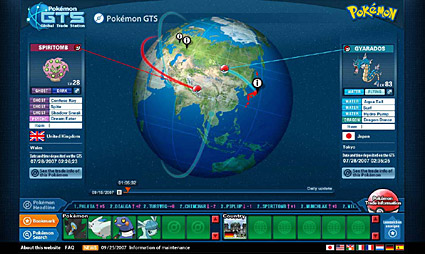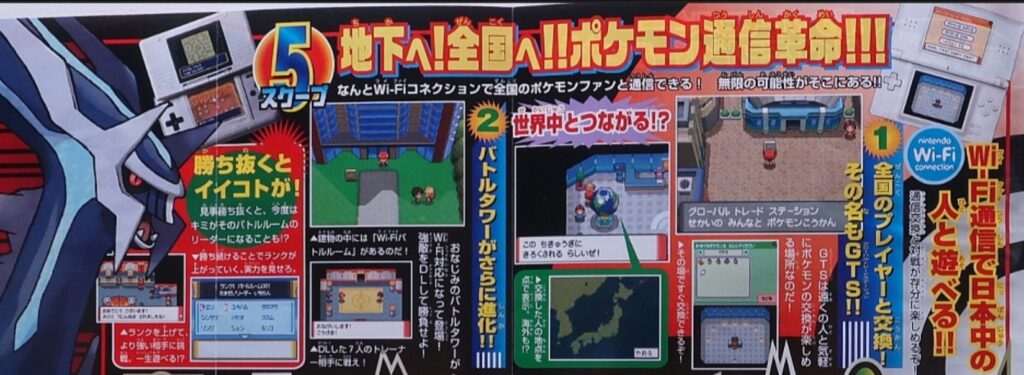Pokémon Diamond & Pearl are a fantastic pair of games. I mean, truly brilliant. What’s that? You’re saying they’re sluggish, poorly optimised, and rather glitchy? Yes, I agree. Go ahead. Put them through the wringer for their technical imperfections all you want. Yet this pair of games forever revolutionised the way we experience Pokémon. Not merely because they marked the transition from 2D to 3D (well, 2.5D) and backlit-screen to touchscreen, but particularly owing to the global WiFi functionality they introduced.
With the release of Diamond & Pearl, it became possible to trade and battle directly with people the world over. For Junichi Masuda and colleagues, this was the realisation of a long-cherished dream. GameFreak and The Pokémon Company made much of it, and rightly so. Diamond & Pearl propelled Pokémon into a new era; its community had gone truly global.
The ultimate showcase of limitless connectivity was, unquestionably, a newfangled feature called the Global Trade Station, or GTS for short. In a franchise first, it facilitated unhindered supply-and-demand style trading on a global scale. Instructional pages went up on the official Pokemon.jp website to teach players how to use the system. CoroCoro Monthly pulled out all the stops and ran two page-filling features in their August and September 2006 issues to showcase Diamond & Pearl’s WiFi features. It may seem quaint now, but anno 2007 it was truly exciting to consult the giant globe in Jubilife’s Global Terminal and gaze at the red map speck that indicated where the Bellsprout you just traded for had come from. (From Aichi, Japan. Whoa! That’s like, 6000 miles away!) Japanese players got Diamond / Pearl seven months before everyone else did, and they were quick to see the possibilities, setting up, for example, a “Bibarel Mail” [ビーダルメール] system to collect TIDs and game Jubilife’s item lottery. It was a brave new world, and players took to it en masse: by June 2007, over 10 million Pokémon had been traded on the GTS worldwide.1One such account of GTS excitement in Japan is here: http://torogamer.fc2web.com/game2007/tomodatitecho.html
Corporate channels, too, understood the GTS’ innovative appeal, and sought ways to showcase its capabilities and entice players to participate in the global revolution!™. Whether the GTS ballooned to spill over into promotions, or promotions were designed to “sell” the GTS (and software copies!), I cannot say. Fact is that from December 2006 onwards, the official Pokémon Fan Club known colloquially as the Daisuki Club (だいすき クラブ) pioneered a series of contests and giveaways that put the GTS front and centre. In August 2007, staffers at Nintendo of America and the Pokémon patriarchs at GameFreak (briefly) followed suit, before the Daisuki Club rehashed their formula one last time in early 2009 to – I suspect – celebrate the release of Platinum.
This is the story of those GTS distributions, and the highly elusive, enigmatic event Pokémon they bought forth.
I’m presenting it to you as a four-part series. While GTS events are best thought of as a continuum, with each “act” building on the lessons and experiences of the previous, these articles can be read as standalone pieces. Hope you enjoy!
Daisuki Club GTS Project:
– Act 1: Let’s! WiFi! Daisuki Club GTS Adventures (December 2006 – March 2007)
– Act 2: The Magikarp of Love (February 2007)
– Act 3: GameFreak Psyduck & Nintendo Heracross (August 2007)
– Act 4: Daisuki Club Goes Platinum (February – April 2009)
For the PokeTimes Exchange Series, see here!

We miss you, pokemon-gts.net!
- Harvest Moon 3 (2001) - March 5, 2020
- Pokémon Trading Card Game 2 (2001) - February 5, 2020
- Yu-Gi-Oh! Dark Duel Stories (2002) - January 5, 2020

